|
|
ARTHROPODS:
Insects»
Spiders»
Centipedes»
Millipedes»
Sowbugs»
Harvestmen»
Mites
& Ticks»
Scorpions»
Identification
Tips»
About
the Critter Files»
Links» |
|
|
|
 |
LIGHTNINGBUGS
AKA
"FIREFLIES"
Critter
Files/Insects/Beetles/Lightningbugs
By Blake Newton
University of Kentucky Department of Entomology |
| |
|
| |
| TAXONOMY |
KINGDOM:
Animalia | PHYLUM: Arthropoda | CLASS: Insecta | ORDER:Coleoptera
| FAMILY:Lampyridae (lightningbugs or fireflies) |
| |
| Other
Names: Fireflies, Lightning Beetles, Lampyrids |
| |
WHAT
IS A LIGHTNINGBUG?
LIFE CYCLE
ECOLOGY
PEST STATUS
COMMON KENTUCKY LIGHTNINGBUGS
COLLECTING & PHOTOGRAPHY
LIGHTNINGBUG FACTS
MYTHS, LEGENDS, AND FOLKLORE |
| |
| WHAT
IS A LIGHTNINGBUG? |
|
Like all
beetles, Lightningbugs, also called Fireflies,
have chewing mouthparts and hardened front wings (elytra) that meet
in a straight line down the back of the abdomen when closed. Most
lightningbugs have glowing abdomens, but even the species that do
not glow are easily recognized by their elongated bodies, distinctive
black-and-orange colors, and their hood-like "pronotums."
|
| |
| All insects have a pronotum,
the first plate on the top of the thorax, but lightningbugs have large
pronotums which conceal the head when viewed from the top. Lightningbugs
are also unusual among beetles because their elytra, while more hardened
than normal insect wings, are much softer than the elytra of most
beetles. Most lightningbug species are about 1/2-3/4" long,
but some species are much smaller, at about 1/4". |
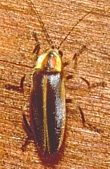 Typical
Lightningbug
Typical
Lightningbug
(B. Newton, 2003) |
| |
| Some species of soldier
beetle (family Cantharidae) closely resemble lightningbugs (shown
below). In fact, lightning beetles and soldier beetles are
closely related. Both are elongated in shape, have relatively
soft elytra, and both are often patterned with black and orange.
|
| |
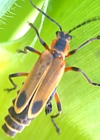 Soldier
Beetle (B. Newton, 2003)
Soldier
Beetle (B. Newton, 2003) |
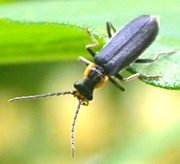 Soldier
Beetle (B. Newton, 2003)
Soldier
Beetle (B. Newton, 2003) |
| |
| However,
the heads of soldier beetles are never concealed by the pronotum (shown
below). |
| |
 Lightningbug:
head concealed by pronotum
Lightningbug:
head concealed by pronotum
(B. Newton, 2003) |
 Soldier
Beetle: head not concealed
Soldier
Beetle: head not concealed
(B. Newton, 2003) |
| |
| Lightningbug
larvae (shown below in the Life Cycle section)
look very similar to sowbugs
or roly-polies and are found in similar habitats (low to the ground
and under rock and logs), but sowbugs have 14 legs, while lightningbug
larvae have only 6 legs. |
|
| SIZE:
Adult and larval body length up to 3/4" |
| |
| LIFE
CYCLE |
|
Like
all beetles, lightningbugs have "complete" metamorphosis
with egg, larval, pupal, and adult stages. Female lightningbugs
place eggs in moist soil on lawns, meadows, and the forest floor.
Upon hatching in the spring, larvae live and feed at the soil
level for 1-3 years, pupating in the spring in small chambers in
soil. Adults emerge in early summer. During mating,
males and females find one another by flashing their luminesecnt
abdomens. Different lightningbug species use different rhythms
while flashing. Some adult females do not fly. Instead,
they rest on the ground or on vegetation and signal for males, who
fly to meet them.
|
| |
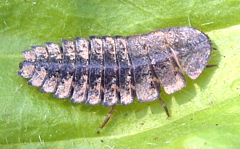 Lightningbug
larva (B. Newton, 2005)
Lightningbug
larva (B. Newton, 2005) |
| |
| ECOLOGY |
|
| |
Larval
lightningbugs are predators that feed on small insects, worms, slugs,
and snails. They are primarilty nocturnal, patroling the thatch
layer in lawns and other locations that are damp and close to the
soil. In the daytime, they hide under loose bark, logs, and
rocks. As adults, some lightningbug species feed on nectar
and pollen, others are predators.
Some lightningbug species
also feed on other lightningbugs. Among these species, larvae
and adults attract other lightningbugs by resting on the ground
or on vegetation and mimicing the mating signals used by other species.
Lightningbugs and their
larvae are a plentiful food source for other animals. Birds,
bats, and spiders feed on the adults. Spiders, ground beetles,
and other soil-dwelling predators feed on the larvae.
|
| |
| PEST
STATUS |
|
Lightningbugs
are not considered pests.
|
| |
| COMMON
KENTUCKY LIGHTNINGBUGS |
|
|
LIGHTNINGBUGS
GENUS: Photinus,
Photuris, others
There are many species
of lightningbugs in Kentucky, but most of them are very similar
in size, appearance, and behavior. In fact, the best way to
distinguish many species is by examining the color of their glowing
abdomens (some species have yellow lights, others have green) and
by their flashing patterns. Common species belong to the Photinus
and Photuris genera, and most of these have dark gray or
brown elytra with yellow or orange borders. A few other species,
including some which do not have luminescent abdomens, have black
elytra with no borders. |
| |
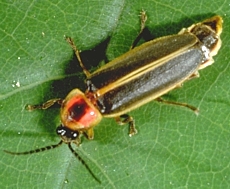 Lightningbug
(R. Bessin, 2000)
Lightningbug
(R. Bessin, 2000) |
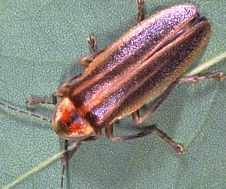 Lightningbug
(R. Bessin, 2000)
Lightningbug
(R. Bessin, 2000) |
|
| |
| COLLECTING
& PHOTOGRAPHY |
|
Lightningbug adults
are easy to find and capture during early summer nights in Kentucky.
Look for them in lawns, meadows, and woodlands. Flying
adults can easily be captured by hand. Larvae can be found
in the same habitats: glowing spots on the ground may be lightningbug
larvae! During the day, look for lightningbug larvae under
logs, mulch, and rocks. Lightningbug adults can sometimes
be found resting on plants during the day. It is best to take
pictures of lightningbugs and their larvae during the day when the
insects are less active and more light is available.
|
| |
| LIGHTNINGBUG
FACTS |
|
Lightningbugs are not
the only insects that are able to glow. Read about other glowing
insects in our online article, Beacons
in the Night.
Read this interesting
article
about the bioluminescent properties of lightningbugs at the Norman
Bird Sanctaury website.
|
| |
| MYTHS
- LEGENDS - FOLKLORE |
|
Because they are so
noticable, lightningbugs have always been a part of human culture,
and they have often been the subject of myth, legend, and folklore.
Europeans once believed that if a lightningbug flew in a window,
a person would soon die. The Chinese believed that lightningbugs
were produced by burning grass. Native Americans smeared glowing
lightningbugs on their faces for decoration. Japanese
believed that fireflies represented the souls of the dead, an idea
expressed in the animated movie, Grave of the Fireflies
(1988). There is also a novel called Fireflies (1970)
by Shiva Naipaul. In the book, a Trinidad man is fascinated
by fireflies on his first trip to the countryside. |
| |
Original document: 25 May 2004
Last updated: 19 Oct 2006
Photos courtesy R. Bessin and B. Newton, University of Kentucky
The Kentucky Critter
Files are maintained by Blake Newton, Department of Entomology, University
of Kentucky.
Contact: blaken@uky.edu
|
|

